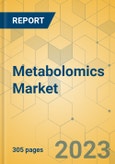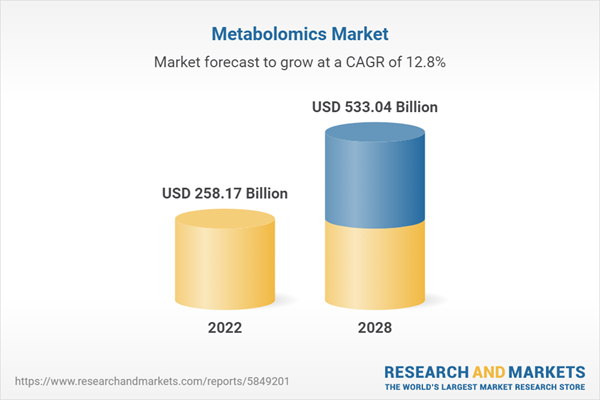Speak directly to the analyst to clarify any post sales queries you may have.
MARKET TRENDS & DRIVERS
Growing Demand for Metabolomics in Food Safety and Quality Control
Metabolomics is becoming an increasingly important tool for food safety and quality control due to its ability to analyze the chemicals produced by organisms as they interact with their environment. Metabolomics allows researchers and producers to assess food's chemical composition, enabling them to detect potentially harmful substances and monitor the overall quality of food. Such factors are projected to affect the metabolomics market growth positively. Metabolomics can also identify adulterated foods, diagnose food-related illnesses, and determine the chemical composition of food-processing by-products. All of these uses can help producers provide consumers with safer and higher-quality food products and help ensure compliance with food safety regulations.Increasing Funding for Metabolomics Research
Increasing funding for metabolomics research would allow researchers to explore further the biochemical processes occurring in organisms. Metabolomics studies the comprehensive view of all the molecules, or metabolites, in the body, which provides an in-depth understanding of the metabolic networks involved in diverse physiological and pathological conditions. More resources allocated to this field of research would enable scientists to understand better the connections between molecular events and their effects on an organism’s health. Research studies may also identify novel biomarkers that target specific aspects of metabolism, potentially aiding in developing more effective diagnostics for diseases and other conditions. Additionally, increased investment in metabolomics could facilitate the discovery of new drug targets and lead to the development of drugs with fewer side effects. The implications of research in this field can lead to a better understanding of the metabolic pathways in humans and other organisms and ultimately provide more personalized and effective treatments.Growing Rate of Target Diseases
Metabolomics is a rapidly growing field of research that is being applied to studying various diseases, including cancer, diabetes, obesity, heart disease, Alzheimer's disease, and Parkinson's disease. By studying the different metabolites in an individual's body, researchers can gain valuable insight into the biochemical processes and potential causes of various diseases. The metabolomics market has paved the way to provide a better understanding of the molecular pathways and biochemical processes involved in the progression of a particular disease. By studying the metabolic pathways of a given disease, it may be possible to identify potential targets for therapeutic interventions.SEGMENTATION INSIGHTS
INSIGHTS BY TECHNOLOGIES
The detection method technologies segment dominated the global metabolomics market, with a share of over 44% in 2022. Metabolomics is a powerful tool in biology and biochemistry, providing insights into the body’s metabolic and physiological processes. Over the last decade, technological advances have made metabolomics increasingly accessible and powerful. One important technology used in metabolomics is mass spectrometry. Mass spectrometry involves passing an ionized sample through a vacuum chamber, where it is broken down into its component elements. These mass spectra can then be used to identify and quantify the different metabolites present in a sample. Mass spectrometry is used in metabolomics to analyze complex metabolic mixtures and to determine the concentration of various metabolites in a sample.Segmentation by Technologies
- Detection Methods
- Separation Methods
- Bioinformatics Tools & Services
INSIGHTS BY APPLICATION
The global metabolomics market by application is segmented into medical & clinical research, plant & food science, and biotechnology. Metabolomics is an ever-growing field of research that is gaining increasing attention due to its potential in medical and clinical applications. The medical and clinical applications of metabolomics are numerous. They can be used to diagnose and monitor diseases and study the effects of drugs, toxins, and other environmental factors on health. Metabolomics can provide insight into the molecular basis of diseases and the mechanisms of the action of drugs. This information can be used to improve drug design and to identify novel therapeutic targets. Metabolomics can also be used to predict drug response in individuals and to identify biomarkers that can be used to evaluate health status. Such factors have helped the medical & clinical research application segment to dominate the global metabolomics market during the forecast period.Segmentation by Application
- Medical & Clinical Research
- Plant & Food Science
- Biotechnology
INSIGHTS BY END-USER
The standalone metabolomics service providers segment accounted for the largest global metabolomics market share in 2022. Metabolomics service providers are becoming increasingly important in the field of research. By offering specialized services, such as sample preparation and analysis, data analysis and interpretation, and metabolite identification and quantification, these companies are helping researchers better understand how cells work and how diseases develop. As the demand for metabolomics services continues to grow, more companies are entering the market and offering specialized services to meet the needs of researchers.Segmentation by End-user
- Standalone Metabolomic Service Providers
- Pharma & Biotech Companies
- Research & Clinical Laboratories
- Others
GEOGRAPHICAL ANALYSIS
North America dominated the global metabolomics market share, accounting for over 40% in 2022, mainly due to the developed infrastructure, increased government projects based on various new biological compound syntheses, advances in metabolomics technologies, and many research laboratories performing studies on various diseases. Metabolomics also has a wide range of applications other than healthcare, such as plant & food science, biofuel, and bioengineering. The most important factor that drives the regional market is the rise in investments in metabolomics. The major contributors in North America are the U.S. and Canada. The publisher predicts that the market in this region will grow at a healthy rate and dominate the global metabolomics market during the forecast period.Segmentation By Geography
- North America
- The U.S.
- Canada
- Europe
- Germany
- France
- The U.K.
- Italy
- Spain
- APAC
- China
- Japan
- India
- South Korea
- Australia
- Latin America
- Brazil
- Mexico
- Argentina
- Middle East & Africa
- Turkey
- South Africa
- Saudi Arabia
COMPETITIVE LANDSCAPE
The global metabolomics market is highly competitive and dynamic due to several international, regional, and local players offering comprehensive metabolomics solutions. Rapid technological changes, frequent new product launches, and changes in industry standards characterize the market. Several companies are compelled to invest in new product development and product enhancement initiatives based on recent technological innovations so that their products are not rendered obsolete over time. Pharmaceutical companies, research and diagnostic laboratories, and healthcare establishments use metabolomics products. Launching more efficient and economical products will result in faster adoption and revolutionize the market.Key Company Profiles
- Agilent Technologies
- Bio-Rad Laboratories
- Danaher
- PerkinElmer
- Thermo Fisher Scientific
Other Prominent Vendors
- Advion
- BGI
- biocrates life sciences
- Bruker
- LECO
- Merck KGaA
- SCION Instruments
- Shimadzu Corporation
- Waters
KEY QUESTIONS ANSWERED:
1. How big is the metabolomics market?2. What is the growth rate of the metabolomics market?
3. What are the rising trends in the metabolomics market?
4. Which region holds the most significant global metabolomics market share?
5. Who are the key players in the global metabolomics market?
Table of Contents
Companies Mentioned
- Agilent Technologies
- Bio-Rad Laboratories
- Danaher
- PerkinElmer
- Thermo Fisher Scientific
- Advion
- BGI
- biocrates life sciences
- Bruker
- LECO
- Merck KGaA
- SCION Instruments
- Shimadzu Corporation
- Waters
Methodology
Our research comprises a mix of primary and secondary research. The secondary research sources that are typically referred to include, but are not limited to, company websites, annual reports, financial reports, company pipeline charts, broker reports, investor presentations and SEC filings, journals and conferences, internal proprietary databases, news articles, press releases, and webcasts specific to the companies operating in any given market.
Primary research involves email interactions with the industry participants across major geographies. The participants who typically take part in such a process include, but are not limited to, CEOs, VPs, business development managers, market intelligence managers, and national sales managers. We primarily rely on internal research work and internal databases that we have populated over the years. We cross-verify our secondary research findings with the primary respondents participating in the study.

LOADING...
Table Information
| Report Attribute | Details |
|---|---|
| No. of Pages | 305 |
| Published | July 2023 |
| Forecast Period | 2022 - 2028 |
| Estimated Market Value ( USD | $ 258.17 Billion |
| Forecasted Market Value ( USD | $ 533.04 Billion |
| Compound Annual Growth Rate | 12.8% |
| Regions Covered | Global |
| No. of Companies Mentioned | 14 |









